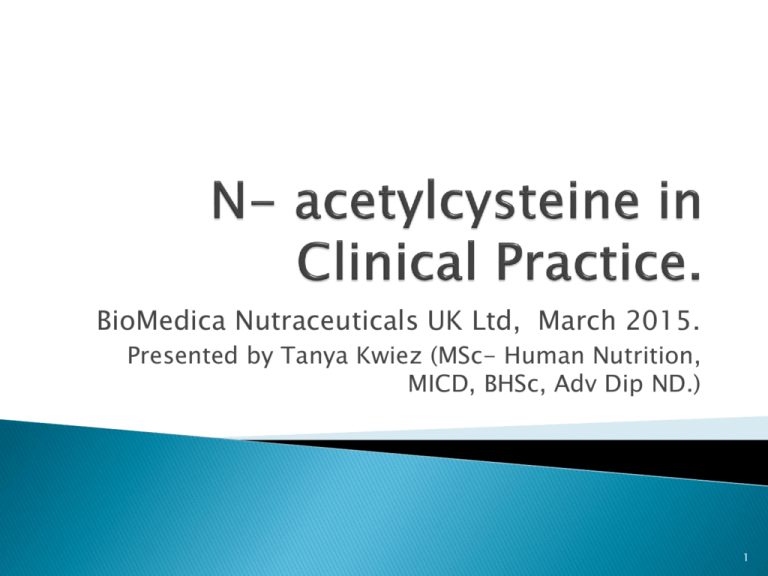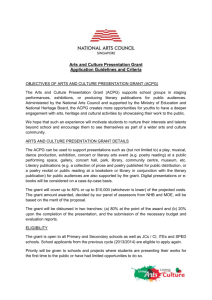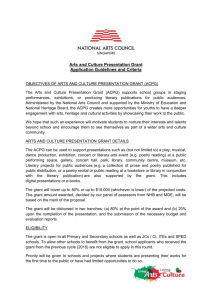ncn-talks-clinical-tanya-kwiez-N-Acetyl-Cysteine-in
advertisement

BioMedica Nutraceuticals UK Ltd, March 2015. Presented by Tanya Kwiez (MSc- Human Nutrition, MICD, BHSc, Adv Dip ND.) 1 The clinical significance of the acetylated form of cysteine and major biological pathways of NAC activity. BioFilms and the significance of biofilm forming organisms in persistent infections. The primary therapeutic actions of NAC and the vast amount of patient cases we can apply it in. Chronic respiratory conditions, H-pylori, fertility, CVD, neuropsychiatry, mental health impact. 2 OH C CH2 CH SH O NH C CH3 O 3 Oral glutathione undergoes digestion. Cysteine rapidly oxidised. Disulphide bonds- NACs sulfhydryl group reacts to split disulphide bridges in proteins. Metal ion complexes (a complex ion has a metal ion centre with molecules/ions surrounding it – ligands.) GSH has a high metal ion binding affinity. Toxic metals- arsenic, cadmium, lead and mercury contribute to chronic diseases. Enhancing natural chelation through NAC: As an orally available precursor to cysteine it chelates toxic elements and stimulates GSH, especially when Vitamins C and E present. 4 Rushworth GF, Megson IL. Existing and potential therapeutic uses for N-acetylcysteine: the need for conversion to intracellular glutathione for antioxidant benefits. Pharmacol Ther. 2014 Feb;141(2):150-9. 5 Oral NAC administration (rapid absorption) Extensive first-pass metabolism in liver and intestine deacetylation LIVER cysteine NAC INTESTINE + glutamate glutamate-cysteine ligase GSH 3% of NAC excreted in feces GSH synthase glycine + Glutamylcystein ee 6 Most famous clinical use of NAC is for acetaminophen poisoning (Tylenol.) Acetaminophen liver metabolism after digestion- metabolite N-acetyl benzoquinoneimine (hepatic glutathione pool depleted.) NAC administration actions replenish GSH levels (Moldeus & Cotgreave, 1994.) Many antioxidants in the body. What distinguishes Glutathione (GSH) from others? Regeneration. Extracellular action to reduce cystine to cysteine which allows transportation into the cell at 10 times faster rate than cystine. Also further use into GSH (Moldeus & Cotgreave, 1994.) Glutathione- capacity to regenerate itself. Glutathione- involved in the regeneration of Vitamin C as well. 7 •Antioxidant •Enzyme cofactor •Immune modulation •Mucolytic •Reduced ligand & receptor affinities e.g. cytokines, angiotensin II* •Biofilm disruption •NMDA modulation •Detoxification •Anti-clotting •Chelation •Antioxidant •Anti-mutagenic & anti-neoplastic •Antiox. •Antimutagenic & antineoplastic 8 Cysteine precursor for GSH synthesis. Enzyme co-factor, antioxidant and immune modulation. Anticlotting, anti mutagenic and anti neoplastic. Mucolytic, biofilm disruption and reduced ligand and receptor affinities; eg- cytokines, angiotensin II. 9 Anti-inflammatory- ↓ TNFα, IL-1β, IL-6, IL-10 & suppressed microglial activation (Sumani et al 2013) Glutaminergic modulation (Sumani et al 2013) Insulin sensitising in PCOS (Riskz et al 2005) Anti-androgenic in PCOS (Fulghesu et al 2002, Riskz et al 2005) Anti-apoptic (in vitro) 10 Relatively low bioavailability from oral dosing -safety significance. 4-10-%: Rapid deacetylation in the intestinal mucosa and first pass liver metabolism. Powerful, safe and effective nutrient (High bioavailability isnt necessary for effective, potent clinical effect. 4-10%- shows how powerful what is absorbed actually is!) Pharmaceutically availability via oral, IV or inhalation (some trials have shown associated risks with IV/ inhalation methods.) Peak plasma levels at 5- 6 hours orally. Take home message- High bioavailability , large doses not usually needed and very safe tolerated oral use. 11 NAC the mucolytic. NAC is also referred as “the slime loosener”. NAC breaks down mucous into smaller, less viscous units. Mucolytic actions: 1. Disruption to the biofilms of persistent infections. 2. Reduction of mucous and viscosity (sulfhydryl group of NAC reacts to split disulfide bonds within bronchial mucous secretions. 3. Improved endoscopy/bronchoscopy visibility. 4. Fertility- improved ovulation in PCOS, reduced semen viscosity. 12 “Asthma and chronic obstructive pulmonary disease (COPD) are inflammatory lung diseases that are characterised by systemic and chronic localized inflammation and oxidative stress.” (Kirkham and Rahman, 2006.) COPD: Numerous clinical trials with NAC. Asthma- Small, single blinded study using 600mg bid NAC with corticosteroids in patients discharged from hospital following asthmatic exacerbation- failed to demonstrate a superior effect (Alivali et al, 2010.) General consensus- COPD patients benefit: particularly patients with moderate- severe forms taking 600mg bid (2x daily) for up to 12 months to prevent exacerbation. (De Backer et al 2013, Rushworth & Megson 2014, Zheng et al 2014.) 13 Chronic Bronchitis: Positive systematic review found 400- 600mg/day for 3-6 months significantly reduced exacerbations and decreased symptoms. Cystic Fibrosis: 1. At lower doses (700mg/day) NAC acts as a mucolytic and general anti-inflammatory. 2. At higher doses (600- 1000mg TID for 1-3 months) increased neutrophil GSH content, reduction in neutrophil influx in CF airways, sputum elastase activity and sputum IL-8 levels (attributed to decreased airway inflammation.) 3. Inhibited MPO- significantly decreased lower respiratory airway oxidative stress. (Vasu et al 2011, Rushworth & Megson 2014.) 14 “Formation of biofilm is a survival strategy for bacteria and fungi to adapt to their living environment, especially in the hostile environment. Under the protection of biofilm, microbial cells in biofilm become tolerant and resistant to antibiotics and the immune responses, which increases the difficulties for the clinical treatment of biofilm infections.” (Wu et al, 2014.) “Lung infection is the main cause of morbidity and mortality in patients with cystic fibrosis and is mainly dominated by Pseudomonas aeruginosa. The biofilm mode of growth makes eradication of the infection impossible, and it causes a chronic inflammation in the airways.” (Ciofu et al, 2014.) 15 A self-produced matrix composed of extracellular polymeric substances including polysaccharides, DNA, proteins and lipids that alter the surface properties of the bacteria themselves to both promote and prevent initial attachment to a surface or cell aggregation Biofilms usually house multiple strains of single species as well as being often polymicrobial Both the matrix & the diverse strains enhance antimicrobial resistance 16 17 Use of either 600mg bid or 400mg bid tds improves eradication rates from antibiotic treatments for H.pylori. Eradication rates were up to doubled in small samples (Zala 1994, Gurbuz 2005.) 2010 study- 2 parts: 1. In vitro- Investigated NACs effects on cultured H.pylori from patients who had 4 failed eradication treatments. 2. Open label clinical trial- 40 patients randomised to receive antibiotics/PPI with or without NAC 600mg/day for 1 week prior to treatment (Cammarota et al, 2010.) 18 Antioxidant role is numerous- Neuropsych, thyroid, IBD, mitochondria, CVD, fertility, athletes. Brain Antioxidants: NAC and vitamin C. Thyroiditis: NAC and Se. Hyperthyroidism: NAC, Se and vitamin E. Mercury chelation: NAC, Se +/- Zn. Superoxide elevation, long term oxidative stress patients: NAC, SOD and vitamin C. 19 2 RCTs confirm increased rates of ovulation with 1-2g/day days 3-7 of menstrual cycle. PCOS: Several trials have suggested reduced IR and androgen levels in PCOS patients treated for 5-6 weeks with 1.8- 3 g/day. Increased rates of ovulation, endometrial layer thickness and pregnancy when given with Clomid (Clomiphene) in PCOS (Fulghesu et al, 2002, Badaway, Baker, El Nasher & El Totongy 2006, Millea 2009, Rizk, Bedaiwy & Al-Inany 2005.) 20 NAC studies often in combination with other antioxidants to improve sperm parameters in men Studies of NAC alone have administered 600mg/d over 12-26wks which have increased sperm motility, concentration & morphology Other trials have found reduced viscosity which may be a key treatment outcome 21 Evidence of GSH depletion in blood vessels of atherosclerotic animals and depleted platelet GSH levels may contribute to over sensitivity to thrombotic stimuli (Rushworth & Megson, 2014.) Small RCT used combination of L-Arginine (1.2g/day) and NAC (600 mg/day) for 6 months reduced BP by ~5mmHg in T2DM patients with HT (Martina et al, 2008.) Homocysteine- Effects have been mixed however Wiklund et al, 1996 reported up to a 45% reduction with 2 grams/day over 2 weeks. 22 23 Autism spectrum (Hardan et al, 2012, Ghanizadeh & Moghimi-Sarani, 2013), small pilot study found reduced symptoms especially irritability. ADHD (Garcia et al, 2013), Small study of Lupus patients found patients with high ADHD scores treated with either 2.4g/day or 4.8g/day for 3 months. 24 Bipolar Disorder (Berk et al 2008, Magalhaes et al 2011, 2013.) 2g per day as an adjunct to stable medication resulted in a dramatic effect sizes in both manic episodes and depression. Schizophrenia (Berk 2008, Lavoie et al 2008, Farokina 2013.) 2 g per day as an adjunct to stable medication: RCTs so far to date suggestive of effect at reducing negative symptoms. Significant QOL improvements. Sub-group analyses revealed better results in late presenters. 25 Depression 2g per day. New unpublished study cited by Professor Berk suggests that greatest benefit seen at the 6 month point of treatment. Sub-group analyses suggest increased efficacy in elderly patients rather than the young. Obsessive Compulsive Disorder (OCD). Anxiety. Addictions- Cannabis, cocaine, nicotine studies. 26 Remembering a little bit goes a long way. Mucolytic: commonly 600mg- 1200mg/day Antioxidant- commonly start on 600mg/day plus accessory nutrients. Mental Health- benefits observed with 2 g/day in most conditions. Athletic performance studies have used significantly higher doses. 27 OCD, ADHD, Addictions and acute brain injury- may benefit from higher dosage 4g/day. (Glutamate higher, higher oxidative stress picture here.) Generally extremely safe. Adverse effects noted with IV and inhalation, not oral dosage. “NAC has a long- established safety record in adults and children, with FDA approval since 1963 (McClure et al, 2014.) 28 “NAC is a safe, inexpensive, and well-tolerated antioxidant with a well-defined mechanism of action. Because of the highly favourable risk/benefit ratio and the low rate of adverse events, physicians might consider use of NAC in select patients to diminish exacerbation of COPD symptoms; reduce the risk of contrast-induced nephropathy; attenuate influenza illness; decrease the rate of deterioration of pulmonary function in idiopathic pulmonary fibrosis; and serve as an adjunct to clomiphene in the treatment of infertility in women with polycystic ovary syndrome.” 29 Berk M, Malhi GS, Gray LJ, Dean OM, The promise of N-acetylcysteine in neuropsychiatry. Trends Pharmacol Sci, 2013 Mar;34 (3): 167-177. Rushworth CF, Megson IL, Existing and potential therapeutic uses for N- Ciofu O, Tolker- Nielson T, Ostrup Jensen P, Wang H & Hoiby N, 2014, acetylcysteine: the need for conversion to intracellular glutathione for antioxidant benefits. Pharmacol Ther: 2014 Feb; 141 (2): 150-159. Antimicrobial resistance, respiratory tract infections and role of biofilms in lung infections in cystic fibrosis patients, Advanced Drug Delivery Reviews, Elsevier. Kirkham P & Rahman I, Oxidative stress in asthma and COPD: Antioxidants as a therapeutic strategy, 2006, Pharmacology & Therapeutics, Vol 111, Iss 2, pp. 476–494 Wu H, Moser C, Wang HZ, Hoiby N & Song ZJ, 2014, Strategies for combating bacterial biofilm infections, International Journal of Oral Science advance online publication 12 December 2014; doi: 10.1038/ijos.2014.65 30




